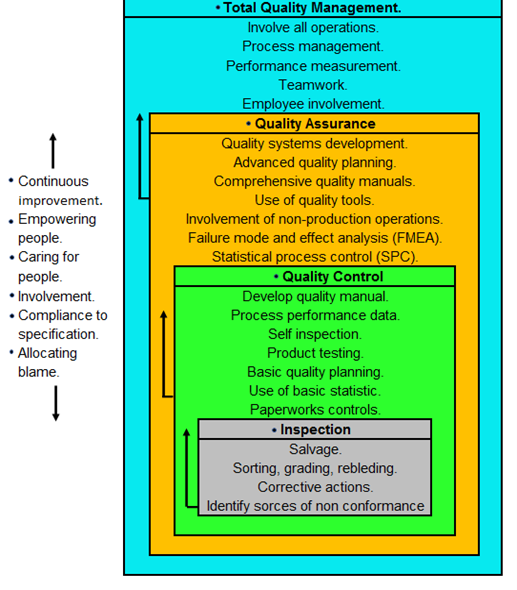- Home
- Levels of Quality Management
LEVELS OF QUALITY MANAGEMENT: Keep It Simple
the levels of quality management integrated discipline

Levels of quality management. The integrated discipline of all elements. The transformation or evolution of quality is a subject that has evolved over time under the influence of various Gurus on the subject when the need arises to offer products highlighting their attributes against those of the competition with the aim of increasing sales, process.
Taking in consideration later than the industrial revolution, the evolution of quality can be divided into four levels/stages.
the levels of quality management as follows:
First Level: Quality by Inspection.
The inspection function consisted of closely and critically examining the work to check its quality and detect errors. In this 1922 stage, Radford's book, Quality control in the factory, was published. For the first time, quality is seen as a management responsibility.
Second Level: Statistical quality control (Product control / Inspection).
The key in this stage is related to the results of Shewhart's research at the Bell Company, which culminated in the publication of the book Economics of control in manufactured products, in which it is define the techniques to evaluate production, control in factories and propose different ways to improve quality. Simple statistical techniques were developed to determine the limits of variation and control charts to present the results that allowed distinguishing the problems inherent in the production process.
In 1946, the American Association for Quality Control (ASQC) was created. At the end of the 1940s, quality was raised to an academic discipline.

Third Level: Quality assurance (Process control).
Arises when it is accepted that statistical control has implications beyond the production department and is extended to the administration of the company. In the 1950s, new elements emerged that gave a twist to quality control: quality costs, total quality control, reliability engineering and zero defects. In 1951, Joseph Juran published the Quality Control Manual, in which he proposed the study of quality costs and the savings that could be generated if it was acted properly.
Armand Feigenbaum was the first to propose the concept of Total Quality Control (TQC). This researcher said that quality products could not be produced if the production department worked in isolation.
Fourth Level: Quality as a competitive strategy (Total Quality Management).
in this stage the methods of the previous stage are still used, important changes occur, since quality becomes of interest to senior management, it is related to profitability, it is defined from the customer's point of view and it is included in the strategic planning process and continuous improvement processes are defined. It becomes a key factor in the competitiveness of companies.
Dr. Feigenbaum's legacy would be honed by Juran, Deming, and Ishikawa and universally recognized as Total Quality Management (TQM).
Due to the innovative contributions of Dr. Feigenbaum, the issue of quality costs according to its origin began to be seriously addressed. Total Quality Control (TQC) is a concept that allows an organization to be seen as an interrelated system, where quality ceases to be a subject of the productive areas to become a subject of all areas. Everyone is involved in it, and directly influences factors that make up customer satisfaction.
The quality control and improvement are based on the 10 principles raised by Feigenbaum, laying the foundations of a system operated by Total Quality Control:
- Quality is company-wide process.
- Quality is what the customer says it is
- Quality and cost are a sum, not a difference
- Quality requires both, individuals and teamwork.
- Quality is a mode of administration
- Quality and innovation are mutually dependent
- Quality is an ethic.
- Quality requires continuous improvement.
- Quality is most cost - effective.
- Quality is implemented with a total system connected with customers and suppliers.
The significance of a total quality management for a company that adopts these principles are organizes production and business processes in such a way as to identify and eliminate problems or sources variations that cause products to deviate from customer needs. To achieve this goal, managers and leaders often follow a simple method known as the Deming cycle: PDCA (Plan, Do, Check, Act).
The Total Quality Management following these core concepts:
- Satisfy the Customer. - The focus here is on external customer. Service and quality management are involved to satisfy the customer means to take due care of the customer’s overall satisfaction like quality, cost, service etc.
- Management by Fact. - The management should know the quality of the product or service that the customer is presently using. This quality level is used as benchmark for further improvement.
- Management based on Human Resources. - The management should emphasize in their employees understand what to do, how to do the job, get the feedback about their performance.
- Total Quality Management is a Continuous Journey. - It is a management and continuous long-term journey. Is a long-term improvement program based on the incremental change.
- Internal Customers are Vital. -Internal customers are more important in comparison to external customers because they are most crucial and complex variable and continuously influence the maintenance of quality.
Currently management systems take an activity of great relevance in aspects of caring for the environment and its resources. Environmental Management is adapted within the Total Quality Management system of the company, aimed at establishing procedures, measures and actions to satisfy environmental requirements and thus achieve a product with a quality that satisfies the consumer.
The total quality environmental management definition it also applies in these areas such as the family ISO 14000, which like the ISO 9000 becomes the management of the system, in this case of environmental relevance, and EMAS the premium management instrument developed by the European Commission, in complement with OHSAS.
This type of management regulations also uses the PDCA cycle in its structure, as well as requiring integration to statistical quality control for its assessment.
Information and more supported materials in our certification programs for your development you will find in InArtifexYou.